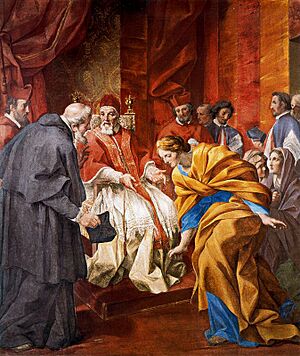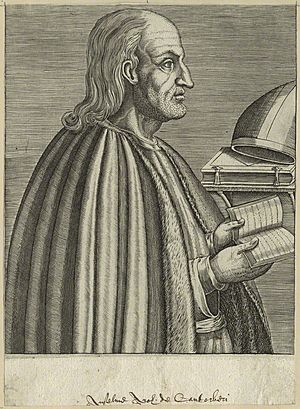Anselm of Canterbury facts for kids
Quick facts for kids Anselm |
|
|---|---|
| Archbishop of Canterbury Doctor of the Church |
|

Anselm described on his stamp
|
|
| Church | Catholic Church |
| Archdiocese | Canterbury |
| See | Canterbury |
| Appointed | 1093 |
| Reign ended | 21 April 1109 |
| Predecessor | Lanfranc |
| Successor | Ralph d'Escures |
| Other posts | Abbot of Bec |
| Orders | |
| Consecration | 4 December 1093 |
| Personal details | |
| Birth name | Anselmo d'Aosta |
| Born | c. 1033 Aosta, Kingdom of Burgundy, Holy Roman Empire |
| Died | 21 April 1109 Canterbury, England |
| Buried | Canterbury Cathedral |
| Parents | Gundulph Ermenberga |
| Occupation | Monk, prior, abbot, archbishop |
| Sainthood | |
| Feast day | 21 April |
| Venerated in | Catholic Church Anglican Communion Lutheranism |
| Title as Saint | Bishop, Confessor, Doctor of the Church (Doctor Magnificus) |
| Canonized | 4 October 1494 Rome, Papal States by Pope Alexander VI |
| Attributes | His mitre, pallium, and crozier His books A ship, representing the spiritual independence of the Church. |
Anselm of Canterbury (born around 1033/4, died 1109) was an important Benedictine monk, philosopher, and theologian from Italy. He became the Archbishop of Canterbury in England from 1093 to 1109. After his death, he was recognized as a saint. His special day is April 21.
As archbishop, Anselm worked hard to protect the Catholic Church's rights in England. He faced challenges from English kings William II and Henry I, which led to him being sent away from England twice. During his time away, he helped guide Greek bishops in southern Italy to follow Roman Catholic practices.
Anselm is famous for creating the ontological argument for the existence of God. This is a way of trying to prove God exists using only logic. He also developed the satisfaction theory of atonement, which explains why Jesus's death was necessary. In 1720, he was named a Doctor of the Church, a special title given to saints who have made important contributions to Christian teaching.
Contents
Biography
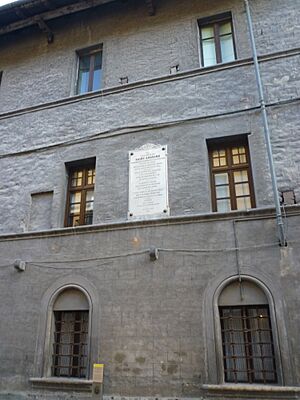
Anselm was born in or near Aosta, a town in what is now Italy, between 1033 and 1034. His family was important, but they had lost some of their wealth. His father, Gundulph, was a noble, and his mother, Ermenberga, was known for being patient and religious.
Early Life and Becoming a Monk
When Anselm was about 15, he wanted to join a monastery. However, his father did not agree, so the monastery refused him. After a period of illness and living a carefree life, his mother died. His father then became very strict, which Anselm found difficult.
At age 23, Anselm left home and traveled through France. He was drawn to the famous Abbey of Bec in Normandy, where his countryman Lanfranc was a leader. In 1060, Anselm decided to become a novice (a beginner monk) at Bec. He was 27 years old. During his first year, he wrote his first philosophical work.
Abbot of Bec
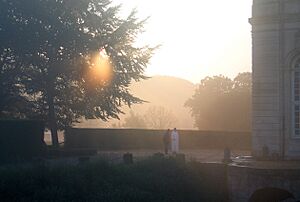
In 1063, Lanfranc left Bec to become the abbot of a new monastery. The monks at Bec chose Anselm to be their new leader, called a prior. He was known for his kind and loving way of guiding the younger monks.
Fifteen years later, in 1078, Anselm was chosen to be the abbot of Bec. Under his leadership, Bec became a very important center for learning in Europe. Students came from many places to study there. During this time, he wrote some of his most famous works, including the Monologion and Proslogion.
Visiting England
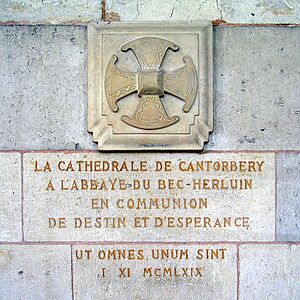
After the Norman Conquest in 1066, Bec Abbey received lands in England. Anselm sometimes visited England to manage these lands and to see William I, who was now King of England. He also visited Lanfranc, who had become the archbishop of Canterbury.
Anselm made a good impression in Canterbury. When Lanfranc died in 1089, King William II (also known as William Rufus) refused to appoint a new archbishop. Instead, he took the church's lands and money for himself. Anselm avoided going to England during this time because he knew the king would want him to become archbishop, and he feared the difficulties this would bring.
However, in 1092, a powerful earl named Hugh of Chester asked Anselm to come to England for advice. While Anselm was there, King William II became very ill. Believing his illness was a punishment for his sins, the king promised to change his ways. On March 6, 1093, he named Anselm as the new Archbishop of Canterbury.
Anselm tried to refuse the position for months, but he was eventually forced to accept. He told the king he would only accept if the king returned church lands, accepted his spiritual advice, and recognized Urban II as the true pope. King William was very reluctant but eventually agreed to some of these conditions. On September 25, 1093, Anselm was officially made Archbishop of Canterbury.
Archbishop of Canterbury

As archbishop, Anselm continued to live by his monastic ideals, focusing on prayer and contemplation. He strongly believed the church should have its own authority, separate from the king's. This belief often clashed with King William II's desire to control both the church and the government.
Conflicts with King William II
One of Anselm's first disagreements with King William II was about money. The king wanted funds for a war and demanded a large sum from Anselm. Anselm offered less, but the king refused it. Anselm also pushed the king to fill other vacant church positions and allow bishops to meet freely. The king became very angry, saying he "hated him before, I hate him now, and shall hate him still more hereafter."

Another major conflict was about the pallium, a special woolen scarf given by the pope to archbishops. Anselm insisted he needed to travel to Rome to get it from Pope Urban II. However, King William had not yet chosen which pope to support (there were two at the time due to a dispute). The king refused to let Anselm go to Rome.
After much debate, the king secretly sent messengers to Urban II, asking the pope to send the pallium to England. The pope's representative brought the pallium, but William still tried to control how Anselm received it. Anselm refused to let the king give it to him, as this would show the church was under the king's power. Finally, the pallium was placed on the altar at Canterbury, and Anselm took it from there.
Over the next two years, William continued to oppose Anselm's efforts to reform the church. In 1097, the king accused Anselm of not providing enough knights for a military campaign and tried to fine him. Feeling that the king was not keeping his promises, Anselm decided to go to Rome to seek the pope's advice. King William again refused him permission. The king gave Anselm a choice: leave England and lose his position, or stay and submit completely to the king.
First Exile
Anselm chose to leave England in October 1097. King William immediately took control of the archbishopric's income. From France, Anselm wrote to Pope Urban II, asking to resign, but the pope refused.
Anselm attended the Council of Bari in October 1098, where he spoke about important church beliefs, including the procession of the Holy Spirit. He also helped guide Greek bishops in southern Italy to adopt Roman Catholic practices. The council also criticized King William II.
Anselm was present at another council in Rome the next year, where the pope again banned kings from appointing church leaders. Anselm then went to France, where he finished his important work, Cur Deus Homo.
Conflicts with King Henry I
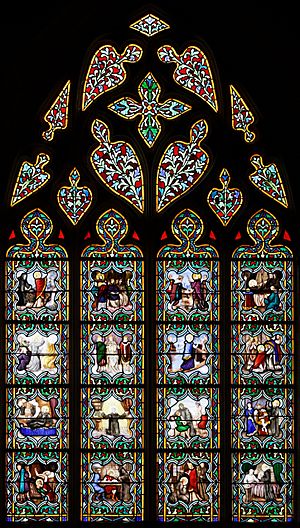
King William II died in 1100. His brother, Henry I, quickly became king. Henry invited Anselm to return to England, promising to follow his advice. However, once Anselm was back, Henry demanded that he perform an act of loyalty (called homage) for his church lands and accept his appointment from the king. Anselm refused, saying this went against church law. Henry, however, did not want to give up a right that previous kings had held.
Anselm supported King Henry against his older brother, Robert, who also wanted the throne. Anselm convinced many nobles to stay loyal to Henry. In 1102, Anselm held a church council in London. This council introduced important reforms, such as forbidding priests from marrying and condemning the buying and selling of church offices.
Despite these reforms, the conflict over appointments continued. In 1103, Anselm traveled to Rome himself to discuss the issue with Pope Paschal II. The pope supported Anselm and even excommunicated (removed from the church) bishops who had accepted appointments from King Henry.
Second Exile
After the pope's ruling, Anselm received a letter from King Henry forbidding his return to England. Anselm stayed in France, waiting for the pope's next move. In 1105, the pope threatened to excommunicate King Henry himself. This was a serious threat, and it worked.
A meeting was arranged between Anselm and King Henry. They reached a compromise: Henry would give up the right to appoint bishops, but Anselm would try to get the pope's permission for church leaders to perform homage for their lands. Henry also agreed to return the church's income and stop taxing married clergy. These agreements strengthened the church's rights against the king.
Anselm still refused to return to England until the pope approved the deal. The pope eventually agreed to the terms, seeing it as a temporary step towards more reforms. Anselm returned to England before the end of 1106.
Final Years

In 1107, the Concordat of London officially formalized the agreement between the king and the archbishop. King Henry formally gave up the right of English kings to appoint church bishops.
Anselm spent his last two years carrying out his duties as archbishop. He died on April 21, 1109. His remains were placed in Canterbury Cathedral.
Writings
Anselm is considered one of the most brilliant thinkers between Saint Augustine and Saint Thomas Aquinas. He is often called the "father of scholasticism", a way of thinking that uses reason to understand Christian faith.
Anselm believed that faith comes before reason, but reason can help us understand our faith better. He famously said, "I do not seek to understand so that I may believe, but I believe so that I may understand." This means he thought you need to trust in God first, and then you can use your mind to explore and understand those beliefs.
Anselm's writings often took the form of dialogues, like conversations between a student and a teacher (who was usually Anselm himself). He tried to explain Christian beliefs using logic and reason.
His most famous works include:
- Monologion (meaning "Monologue"): Written between 1075 and 1076, this book tries to prove God's existence and attributes (like goodness and greatness) using only reason, without relying on the Bible.
- Proslogion (meaning "Discourse"): Written between 1077 and 1078, this book contains Anselm's famous "single argument" for God's existence, now known as the ontological argument. He argued that if we can imagine a being so great that nothing greater can be thought, then that being must exist in reality.
- Cur Deus Homo (meaning "Why God was a Man"): Written between 1095 and 1098, this work explains why Jesus's crucifixion was necessary to make up for humanity's sins. Anselm argued that human sin offended God infinitely, and only an infinite being (Jesus, who was both God and man) could offer an infinite payment to restore justice.
Anselm also wrote many letters, nearly 500 of them, to other church leaders, monks, and family members. These letters often shared his religious beliefs and advice.
Legacy
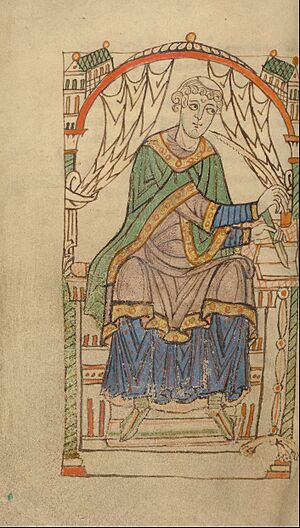
After Anselm's death, two biographies were written about him by his chaplain, Eadmer, and another monk, Alexander. Eadmer also wrote a history that detailed Anselm's struggles with the English kings.
Anselm's ideas greatly influenced later thinkers, especially those in the Scholastic movement, like Thomas Aquinas. His thoughts continue to be important in discussions about the Holy Spirit and the atonement. He is remembered for his strong defense of the church's independence and his deep philosophical insights.
Veneration
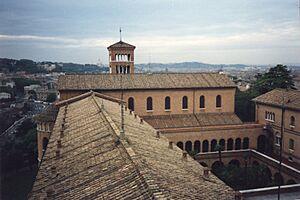
Anselm was officially recognized as a saint by Pope Alexander VI in 1494 or 1497. His feast day is celebrated on April 21 by the Roman Catholic Church and many Anglican churches.
In 1720, Pope Clement XI declared Anselm a Doctor of the Church, giving him the title doctor magnificus ("Magnificent Doctor"). A chapel in Canterbury Cathedral is dedicated to him. In Rome, the Pontifical Atheneum of St. Anselm (a university) and the church of Sant'Anselmo all'Aventino are named in his honor.
In 2015, the current Archbishop of Canterbury, Justin Welby, created the Community of Saint Anselm, a group of young Christians who live at Lambeth Palace and focus on prayer and helping those in need.
See also
 In Spanish: Anselmo de Canterbury para niños
In Spanish: Anselmo de Canterbury para niños
- Fides quaerens intellectum
- Other Anselms and Saint Anselms
- Saint Anselm's, various places named in Anselm's honor
- Cur Deus Homo
- Cluny and Gregorian Reform
- Investiture Controversy
- Canterbury–York dispute
- Saint Anselm of Canterbury, patron saint archive
- Slavery in the British Isles
- Scholasticism
- Existence of God



